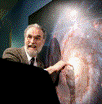Department of Physics and Astronomy: Publications and Other Research

C. Martin Gaskell Publications
Document Type
Article
Date of this Version
10-17-2006
Abstract
We present low-resolution ultraviolet spectra of 14 low redshift (z em < 0.8) quasars observed with HST/STIS as part of a Snap project to understand the relationship between quasar outflows and luminosity. By design, all observations cover the C IV emission line. Nine of the quasars are from the Hamburg-ESO catalog, three are from the Palomar-Green catalog, and one is from the Parkes catalog. The sample contains a few interesting quasars including two broad absorption line (BAL) quasars (HE 0143- 3535, HE0436-2614), one quasar with a mini-BAL (HE 1105-0746), and one quasar with associated narrow absorption (HE 0409-5004). These BAL quasars are among the brightest known (though not the most luminous) since they lie at z em< 0.8. We compare the properties of these BAL quasars to the z em < 0.5 Palomar-Green and z em> 1.4 Large Bright Quasar samples. By design, our objects sample luminosities in between these two surveys, and our four absorbed objects are consistent with the υ ∼L 0.62 relation derived by Laor & Brandt (2002). Another quasar, HE0441-2826, contains extremely weak emission lines and our spectrum is consistent with a simple power- law continuum. The quasar is radio-loud, but has a steep spectral index and a lobe- dominated morphology, which argues against it being a blazar. The unusual spectrum of this quasar resembles the spectra of the quasars PG1407+265, SDSS J1136+0242, and PKS 1004+13 for which several possible explanations have been entertained.


Comments
Accepted for publication in The Astronomical Journal (projected vol 133); online at astro-ph/0610435. Copyright 2006. Permission to use.